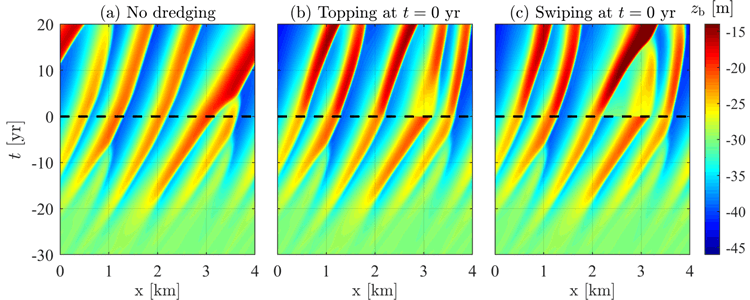G.H.P.Campmans1*, P.C. Roos1, S.J.M.H. Hulscher1
1University of Twente,
Introduction
Tidal sand waves are large scale bed forms observed in many tidally dominates sandy shallow seas, such as the North Sea. They often interfere with offshore human activities, such as navigation, because they are dynamic, are frequently surveyed and dredged. For both, surveying frequencies and dredging strategies, knowledge on sand wave recovery is required.
Methods
To describe sand wave dynamics we use the nonlinear sand wave model by Campmans et al. (2018). First, an equilibrium sand wave profile is obtained on a short domain allowing for a single sand wave in a horizontally periodic domain. Then, to investigate the sand wave response to dredging, this equilibrium sand wave profile is modified to represent sand extraction or redistribution. We look at two types of dredging: 1) topping, were the sand volume above a certain height is removed and 2) swiping, where the 'topped' sand is moved to the sand wave trough such that sand is being conserved. For various dredged volumes of sand the response of a single dredging intervention is investigated. Next to isolated in time dredging interventions, recurring dredging interventions are investigated. Sand waves are being dredged when their crest elevation exceeds a critical height, for instance determined for navigation purposes. Finally, the we look at dredging the highest sand wave in a sand wave field in a longer periodic domain.
Results
Using this model we find that the recovery time of sand waves to equilibrium depend increases with the dredged volume and is longer for swiping compared to topping. When recurrent dredging of the swiping type is applied the times in between consecutive dredging events is not constant. The time between the first two dredging events is the shortest and the time between later dredging events increases towards an equilibrium. The reason for this is that next to sand wave height, the shape of the sand wave matters for its recovery.

Figure 1 dredging the highest crest in a quasi-equilibrium sand wave field: (a) the undisturbed sand wave field (b) the topping of the highest sand wave crest and (c) swiping the topped sand volume to the trough to the left. This figure is adapted after Campmans et al. (subm.).
References
Campmans, G.H.P., Roos, P.C., de Vriend, H.J., Hulscher, S.J.M.H., 2018. The influence of storms on sand wave evolution: a nonlinear idealized modeling approach. Journal of Geophysical Research: Earth Surface 123, 2070-2086.
Campmans, G.H.P., Roos, P.C., Van der Sleen, N.R., Hulscher, S.J.M.H., submitted. Modelling tidal sand wave recovery after dredging: effects of different types of dredging strategies.
I. Surname1*, F.N. Another-Surname2 , Y. Next-Surname2
1 University Name, Country; 2 Organization Name, Country
* Corresponding author: mail.name@organization.org


